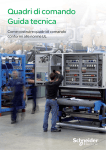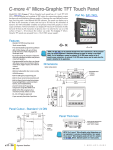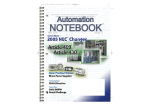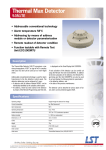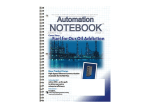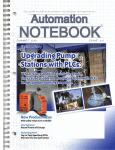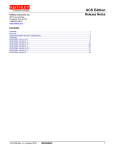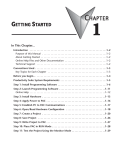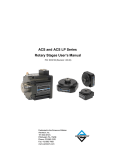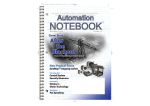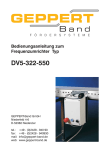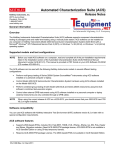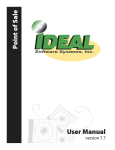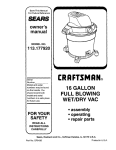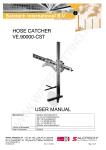Download Issue 9, 2007 - AutomationDirect
Transcript
0706_AutomationNotebook_issue9_rev:0706_AutomationNotebook_issue9_new.qxd 6/4/2007 3:28 PM Page 1 0706_AutomationNotebook_issue9_rev:0706_AutomationNotebook_issue9_new.qxd 6/4/2007 3:29 PM Page 2 Automation Notebook Summer 2007 Issue Nine Your guide to practical products, technologies and applications * Panel-mount or DIN rail adapter available for easy installation * Wide sensing range up to 0-200A models * 5-year warranty Contributors Publisher’s Note Table of Contents Publisher Tina Crowe New Product Focus Managing Editor Joan Welty The inaugural issue of Automation Notebook mailed three short years ago in June of 2004. At that time, we had outgrown our newsletter and wanted to offer more technical columns, tutorials, and articles to our readers. Recently, I have been asked about frequency of the issue and our mailing schedule. Although we strive to produce this publication consistently, we may vary between two and three issues per year depending upon product launch and catalog schedules. We strive to be efficient with our mailing process to keep you informed with timely information. Having been part of the AutomationDirect team since 1996, I am elated to be part of this growing company dedicated to supporting this industry and you – our customers. I’ve had the pleasure of meeting top editors and have a deep appreciation for their insight in this constantly evolving field of technology. One such editor is Larry Berardinis; we are especially honored to have Larry as our guest writer with a special focus on the U.S manufacturing sector. Innovative technology has altered the way many businesses operate today. While concerns of outsourcing abound, U.S. manufacturers are working toward increased efficiencies as a key competitive driver as they strive to keep manufacturing here, and overall, I think you will see the results are more promising than we realize. I hope you will continue to send your comments and suggestions to us; we hope you enjoy this issue of Automation Notebook. Feature Editor Design Manager TJ Johns Justin Stegall Contributing Writers Larry Berardinis Jeff Anderson Chip McDaniel Joan Welty * Quick response times, as low as 100mS * Current switches and 0-10V output transducers are self-powered * Multiple input range models offer flexibility in a single unit to reduce unique components needed * Split-core models available for easy retrofit applications Phone . . . . . . . . . . 1-800-633-0405 or 1-770-889-2858 Fax . . . . . . . . . . . . . 1-770-889-7876 Our new ACUAMP line of current sensors are an excellent way to monitor loads for power consumption or abnormal conditions. From low-cost switches to True RMS transducers, we have a current sensor that will help you improve your process or make maintenance easier. • ACT series transducers have jumper-selectable current input ranges and industry-standard 4-20mA or 0-10 VDC outputs ideal for remote monitoring, data logging and alarming • ACTR series True RMS transducers combine a current transformer and true RMS signal conditioner in one unit for accurate measurement of distorted waveforms, SCRs, power supply and ballast input power • ACS series current operated switches offer discrete outputs for low-cost status indication and alarming • ACSX series current-operated switches offer higher performance with a field-adjustable time delay feature to minimize nuisance trips Monday - Friday 9 a.m. to 6:00 p.m. EST CHECK OUT PRICES ON CURRENT SENSORS Product Description AutomationDirect www.automationdirect.com Copyright 2007, Automationdirect.com Incorporated/All Rights Reserved ACUAMP Price/Part Number $ AC current transducer, fixed-core, selectable 0-10, 0-20, 0-50A input ranges, 0-10VDC output AC current transducer, true RMS, split-core, selectable 0-2, 0-5A input ranges, 4-20mA out CONTACTS Automationdirect.com Inc. 3505 Hutchinson Road Cumming, GA 30040 85.00 ACT050-10-F 154.00 ACTR005-42L-S $ 63.00 ACS150-AE-F AC adjustable current switch, fixed-core, single 1-150A input range, 240VAC/DC output $ AC adjustable current switch, split-core, multi-input ranges from 1.75 to 200A, 30VDC out $ AC adjustable current switch, fixed-core, multi-input ranges, time-adjustable 1A@240VAC out $ 79.00 ACS200-AD-S 83.00 ACSX200-AA-F AutomationDirect prices are May 2007 prices. Prices subject to change without notice. For complete information or to order, visit: www.automationdirect.com/currentsensors No part of this publication shall be copied, reproduced, or transmitted in any way without the prior, written consent of Automationdirect.com Incorporated. Automationdirect retains the exclusive rights to all information included in this document. If you are a non-subscriber and would like to be included in the next mailing of AutomationNotebook, please visit: http://www.automationnotebook.com/ freestuff.html on the Automation Notebook Web site, and complete the details. You can also request FREE stuff, including our catalog and our CD-ROM featuring the entire catalog and demo software. If you provide your email address, we will send news and product information from time to time as well. For those who prefer to speak with us in person, please call 1-800-633-0405 x1845. Thanks for your interest, and we look forward to hearing from you. 4 AutomationDirect launches new line of current sensors Product Snapshots 6 AboutPLCs.com, Learn.AutomationDirect.com, Allen-Bradley DF1 added to C-more micro, Fusible and Non-Fusible Disconnect Switches Cover Story 8 Made in America: Opinions abound, but the facts show U.S. manufacturing to be a global powerhouse evolving to meet tomorrow’s changing needs Feature Story 12 Anti-terrorist barriers help protect facilities Technical Review 15 Electromechanical relays versus solid-state: Each has its place Business Notes 17 Goings-On in the Automation Industry Technology Brief 18 Semiconductor breakthroughs promise smaller, faster chips Tech Thread 20 Welcome PAC: Moving on to the next generation controller FYI 24 DL205 frequently asked questions The Break Room 26 Best in Show, Brainteasers Tina Crowe Publisher [email protected] www.automationnotebook.com 3 0706_AutomationNotebook_issue9_rev:0706_AutomationNotebook_issue9_new.qxd 6/4/2007 3:30 PM Page 4 New Product Focus What’s New AutomationDirect launches new line of current sensors A utomationDirect announces the addition of current sensors to its product offerings. The AcuAMP series is a family of high performance current sensors offering outstanding features, flexibility, and durability. Backed with a five-year warranty, the complete line of current sensors, transducers, and switches will provide dependable service for virtually any application. The ACT series current transducers, available in split-core and fixed-core models, has jumper-selectable current input ranges and industry standard 4-20 mA or 0-10 VDC outputs. This factory matched and calibrated single piece transducer is more accurate than traditional two-piece field-installed products. ACT series current transducers are ideal for remote monitoring and software alarms. Split-core models make using portable data loggers easy, and simple connection enables power consumption or other motor status display. For safety 4 and to eliminate voltage drop, the output is magnetically isolated from the input. The ACT series current transducers are UL, cUL, and CE approved and prices start at $73. The ACTR series current transducers combine a current transformer and a True RMS signal conditioner into one unit. Available with 4-20 mA output, ACTR current transducers utilize True RMS technology for accuracy on distorted waveforms such as VFD or SCR outputs. These transducers are an excellent way to monitor motor and load operation via VFD outputs. ACTR current transducers also provide accurate measurement of phase angle fired or burst fired SCRs, giving faster response than temperature measurement. True RMS sensing is the most accurate way to measure power supply or ballast input power. ACTR current transducers are UL, cUL, and CE approved and prices start at $125. The new AcuAMP series also includes current operated switches equipped with LED status indication. The ACS150 series current operated switches combine a current transformer, signal conditioner, and limit alarm into one package. Available in fixed-core and split-core models, ACS150 switches are ideal for use in monitoring or proof of operation applications. The self-powered ACS150 is equipped with an adjustable setpoint range of 1-150 amps and universal, solid-state outputs and can be tailored to provide accurate and dependable digital indication of over-current conditions for a broad range of applications. ACS150 series current operated switches are UL, cUL, and CE approved and prices start at $63. The ACS200 series current operated switches are equipped with a choice of three jumper-selectable input ranges so it can be tailored to an application and provide more precision in setpoint adjustment. In addition to being self- powered, standard features include isolated solid-state relay outputs, multiple input ranges, and split-core or fixed-core models. The ACS200 series current operated switches are UL, cUL, and CE approved and prices start at $68. The ACSX series high-performance current operated switch has a field-adjustable time delay feature to minimize trips from high inrush or short overload conditions during start-up and operation. These switches are designed for motor status applications where setpoint accuracy and repeatability are critical. The adjustable start-up/delay timer is field adjustable from 0.2 to 15 seconds. The ACSX series is available in either normally open AC or AC/DC outputs for use with most standard motor control systems. The switch serves as an electronic proof-of-operation by detecting current draw changes in motors when they encounter problems such as pumps running dry or pending breaking failure. The ACSX series switch also provides much quicker response time than Class 10 overload relays. The ACSX series switches are UL and cUL listed and CE approval is pending. Prices start at $79. The complete AcuAMP series of transducers and switches can utilize a DIN rail adapter priced at $3.50 for a pack of two. Molded Case Circuit Breakers for branch and feeder circuit protection, starting at $157 U.S. Made by Eaton Electrical, Inc., Manufacturer of Cutler-Hammer products. • • • • G, F, K and L-frame sizes from 15 to 600 amps High-speed “blow-open” action Small size saves panel space UL489 listing www.automationdirect.com/circuit_protection Ferraz Shawmut disconnects help you meet standards Get unmatched circuit protection with 600 VAC/250 VDC heavy-duty fusible and non-fusible disconnects from Ferraz Shawmut. Meeting UL98 standards, the SIRCO and FUSERBLOC series are designed with the latest disconnect technology available, “make and break” power circuits under load, and are UL, CSA, CE and IEC rated. A wide array of handles is available for OSHA padlocking requirements, NEMA configurations, defeater options and NFPA 79 requirements. Check the chart for just a few examples of the components we carry. CHECK OUT OUR PRICES Time-delay and fast-acting general purpose fuses for control and electronic needs • SIRCO non-fusible disconnect switches are available up to 800 amp ratings, starting at $57 • FUSERBLOC series of fusible disconnects start at $85, break up to 200 amps, with double break contacts per pole; use with class CC or J fuses • Applications include service entrance and main panel disconnecting • Accessories include handles and shafts, terminal lugs and shrouds, auxiliary contacts AutomationDirect ABB Ferraz Shawmut Enclosures Price/Part Number Price/Part Number Fusible disconnect, 30A (takes Class J fuses) $115.00 FBJ30 $280.12 OS30AJ12 Fusible disconnect, 200A (takes Class J fuses) $449.00 FBJ200 $1,380.00 OS200J03 Non-fusible disconnect, 400A rating $449.00 SCV400 $1,420.00 OT400U12 Non-fusible disconnect, 600A rating $740.00 SC600 $2,200.00 OETL-NF600ASW *All prices are U.S. published prices. AutomationDirect prices are as of April 2007. ABB prices are taken from ABB Publication LV023, No. 1SXU 000 23 C0201, November 2005. Prices may vary by dealer. Many other part numbers are available from vendors. • Small dimension glass and ceramic fuses ideal for protecting PLC outputs, pilot lights • Class M Midget fuses for supplemental protection of transformers, solenoids; motor branch circuit protection For more information or to order, visit: www.automationdirect.com/disconnects www.automationdirect.com/fuses WMS series of supplementary protectors from Eaton Cutler-Hammer to protect against short circuits and overloads, starting at $8.50 U.S. 250-600 VAC rated current limiting Edison Fuses replace more expensive competitors’ fuses • 1, 2 and 3-pole models • UL 1077 recognized • Full line of accessories • Class CC for lighting and heating loads, small motor circuits • Class J for inductive loads, including motor and motor branch circuits • Class RK for AC power distribution, lighting • PSM metal series in 12 and 24 VDC adjustable output models from 78 to 600W • PSP plastic-housed ultracompact series in 5, 12 and 24 VDC models up to 8A output current www.automationdirect.com/circuit_protection www.automationdirect.com/fuses www.automationdirect.com/power RHINO DC switching power supplies with 3-year warranty start as low as $56 U.S. 0706_AutomationNotebook_issue9_rev:0706_AutomationNotebook_issue9_new.qxd 6/4/2007 3:31 PM Page 6 Product Snapshots Press Releases SLC5/03, 5/04, 5/05 and Micrologix 1000, 1200, and 1500 PLCs in half and full duplex. The new drivers also allow full duplex communication with AllenBradley’s PLC5. Communication cables for connection to A-B PLCs are available for $20.00. To learn more about C-more Micro, go to: http://c-moremicro.automationdirect.com. AboutPLCs.com is all about PLCs AutomationDirect’s newest productfocused Web site features PLCs. AboutPLCs.com pulls together information on the specification, selection, configuration and application of PLCs. Find links to automation sites, training, forums, weblogs and more. AboutPLCs.com also provides in-depth information on AutomationDirect’s DirectLOGIC PLCs. Read Spotlight Feature Stories to learn interesting ways PLCs are used in industrial control. Keep up to date with the latest news headlines in the world of manufacturing. To see more, visit www.aboutplcs.com. motors, and more. This new learning site is updated regularly, adding more videos covering more products and general information about industrial control. Each page of learn.automationdirect.com also has a link to our suggestions page where you can provide feedback and suggestions on information currently on the site. You can also provide input regarding any tutorial video you would like to see added. Be sure to check out http://learn.automationdirect.com. Make the site a bookmark in your Favorites section on your Internet browser. We’re sure you will return time and time again. Allen-Bradley DF1 protocols added to C-more micro Find answers at learn.automationdirect.com Learn.automationdirect.com is an online streaming tutorial site featuring video tutorials providing product information and training on a variety of industrial control topics. Watch informative 1 to 30 minute segments covering product categories including PLCs, operator interfaces, software, sensors, motor control, drives and 6 C-more Micro-Graphic operator interface panels now support AllenBradley DF1 protocols when used with the EA-MG-SP1 Communication option module. C-more Micro will now communicate with Allen-Bradley The C-more Micro is a graphical operator interface panel at a text panel price. Choose either the touch or non-touch version depending on your application and budget. Either way, you get advanced features at prices you might typically be paying for more limited text panels: Fusible and Non-Fusible Disconnect Switches from AutomationDirect AutomationDirect offers 600 VAC/250 VDC heavy-duty fusible and non-fusible disconnects from Ferraz Shawmut. Meeting UL98 standards, the SIRCO and FUSERBLOC series are designed with the latest disconnect technology available, “make and break” power circuits under load, and are UL, CSA, CE and IEC rated. A wide array of handles is available to meet OSHA padlocking requirements, NEMA configurations, defeater options and NFPA 79 requirements. The SIRCO switches and accessories, starting at $57, are available in 30-800 amp ratings. Available defeatable pistol handles automatically re-latch when the panel door is closed, eliminating the need for tools to reset the latch. FUSERBLOC fusible disconnects and accessories, starting at $85, break up to 200 amps and use double break contacts per pole, isolating the fuse while the switch is in the OFF position. Used with class CC or J fuses, FUSERBLOC switches provide reliable circuit protection. For more information, go to: www.automationdirect.com/disconnects. • Five backlight colors that can alert operators to conditions by changing or flashing the color of the screen • Five dual-purpose configurable function keys with individual LEDs • Recipes • Alarms • Up to 999 screens (dependent on screen complexity) • Protocols supported: * All AutomationDirect PLCs * Modbus RTU * Allen-Bradley DF1 half/full duplex, PLC5 DF1 Combine these features and more with the free downloadable programming software* and you have a panel that’s flexible, cost-effective, and is perfect for a wide array of applications. * The programming software is free when downloaded from the Automationdirect Web site, or the CD-ROM package can be purchased for $25 (part # EA-MG-PGMSW). SPECIFICATIONS C-more micro For additional data entry and control, select from one of the optional keypad bezels available in a numeric with control buttons keypad or a simple control button keypad. And they’re plug and play, no software configuration required! Screen Size 3 inch Pixel Resolution 128 x 64 Lines of Text (max) 10 Characters per Line 21 dynamic or 32 static Beeper/Buzzer Yes Graphics Yes Agency Approvals & Certifications UL, cUL, CE, RoHS, NEMA 4/4X indoor use Memory 768 kB Programming Software Price FREE download or $25 for CD Number of Screens 999 Screens Max, limited by memory For a full tour of the hardware and software, visit: www.c-moremicro.com 0706_AutomationNotebook_issue9_rev:0706_AutomationNotebook_issue9_new.qxd 6/4/2007 3:31 PM Page 8 Automation Notebook Summer 2007 Issue Nine Cover Story The State of U.S. Manufacturing Made in America: Opinions abound, but the facts show U.S. manufacturing to be a global powerhouse evolving to meet tomorrow’s changing needs. by Larry Berardinis, Editor, Motion Systems Design S ince the early American settlers began making their own goods in their new homeland, U.S. manufacturing has been an engine of incredible wealth. In simply meeting the essential needs of life - providing food, clothing, shelter, and safety – it has created a standard of living that benefits hundreds of millions of people, not just domestically but also abroad. Where riches are plentiful, however, so too are thieves. From the shop floor to the boardroom, from Wall Street to Capitol Hill, in courtrooms and in union halls, innumerable profiteers have glommed on to American industry, putting enormous pressure on the system keeping us, and them, alive. The good news is that, despite the strain, U.S. manufacturing remains strong and its better days, believe it or not, are yet to come. Alive and well Last year, the National Association of Manufacturers released a report on the state of U.S. manufacturing. In contrast to the bleak picture often portrayed on TV and in newspapers, The Facts About Modern Manufacturing reveals a dominant industry that’s one of the primary contributors to America’s success. “Manufacturing output in America is at an all-time high, playing a central role in our economy,” says John Engler, president of the National Association of Manufacturers. “If it functioned on its own, U.S. manufacturing would be the eighth largest economy in the world,” he adds. “All too often, the perception is that American manufacturing’s heyday is in the past, but nothing could be further 8 from the truth,” says Jerry Jasinowski, president of the Manufacturing Institute, the research and education arm of the National Association of Manufacturers. “The facts show that manufacturing drives economic growth, productivity, and innovation in the U.S., and will continue to do so for years to come,” he adds. more than 60 percent of the products America exports, helping offset the cost of what we buy from abroad. What agricultural exporters bring in each year, about $50 billion, manufacturers take in each month. This is especially weighty in light of the claim by former Federal Reserve Chairman Alan Greenspan that the three sources of original wealth are agriculture, manufacFigure 1. If U.S. manufacturing was a country by itself, it would be the eighth largest economy in the world. turing, and mining. Besides its role in producing new wealth, manufacturing has a huge multiplier effect on the economy. Each manufacturing dollar generates an additional $1.37 in economic activity. Manufacturing also provides nearly half of all corporate taxes collected by state and local governments, while funding more than 70 percent of the R&D conducted in the private sector. Courtesy of: National Association of Manufacturers. Sources: International Facing challenge Monetary Fund and Bureau of Economic Analysis, 2005. In its recent report, One of the key observations made the National Association of in the report is that manufacturing Manufacturers makes it clear that, influences the U.S. Gross Domestic although U.S. manufacturing is strong, Product more than any other market it is continually being challenged on segment. Its contribution to real growth many fronts. “Manufacturers in the since 2001 ranks highest among all United States face unprecedented sectors at 15 percent. In 2005 alone, challenges ranging from rising energy manufacturing contributed $1.5 trillion and health care costs to a shortage of to the GDP and it continues to grow skilled production workers, scientists, faster than the economy overall. and engineers,” warns John Engler, This upward trend, according to NAM president. the report, owes largely to improvements One area where America’s in productivity. Over the past decade, dominance is in jeopardy is our manufacturing productivity more than investment in research and development. doubled. Today, more goods are made in America than any time in U.S. history. The U.S. presently accounts for 40 The casual observer may equate produc- percent of all R&D spending in the tivity to widgets per minute, but in the industrial world, but the ratios are big picture, it’s measured in wages and changing quickly, and not in our favor, benefit compensation. In fact, produc- because federal spending has fallen in the tivity growth is “perhaps the single most past 20 years. In 1985, America invested important determinant of average living 0.25 percent of the GDP into R&D; standards,” says Ben Bernanke, Federal today it’s only 0.13 percent. Reserve Chairman. “Since World War II, federal Another relevant fact in the report support for industrial research has been a is that manufactured goods account for key source of American innovation,” Kingdom, tort costs are less than one percent of the GDP; in the U.S., they’re more than double, amounting to $250 billion a year, much of it sucked from the manufacturing sector. Figure 2. Two-thirds of manufacturing’s GDP is spread across nine industries, which includes both durable and nondurable sectors. Another challenge cited by the report involves government regulations. In 2005, the regulatory load on U.S. manufacturers was $162 billion, 32 percent higher than that imposed on manufacturers by our nine biggest trading partners. Manufacturers also face higher taxes in the U.S. The corporate tax rate here is about 40 percent, compared to 28 percent, and falling, in developed nations with which we compete. Courtesy of: National Association of Manufacturers. Source: NAM calculations based on U.S. Dept. of Commerce data, 2004. Rising health care costs are yet another now spends two percent of the GDP on concern. Driven by escalating tort claims, making the loss of R&D malpractice claims and insurance support even worse. premiums, health care now consumes up Another challenge facing manufac- to a third of the revenues manufacturers turers is a growing manpower shortage. bring in. Were it not for these structural In a recent survey conducted by the (non-wage) cost disadvantages - health Manufacturing Institute, over 80 percent care, taxes, liability, and regulatory of manufacturers said they could not expenses - manufacturing in the U.S. find qualified workers to fill open posi- would be more economical than in tions. Compounding the problem, our Germany, France, Canada, and the colleges are producing fewer engineers U.K., and roughly on par with and our high schools are graduating South Korea. fewer seniors with the skills necessary for Perhaps the most complex today’s more technical jobs. Jasinowski explains. “But R&D spending is now half of its mid 1960’s peak, when it was two percent of the GDP.” By comparison, the United States According to the report, in 2000, 23 percent of all undergraduate degrees awarded globally were in natural science or engineering. The U.S. was far below the average at 11 percent, while China, at 50 percent, was far above. Perhaps one reason fewer people are going into engineering is that our runaway tort system makes it much easier to take wealth than create it. Rising tort costs are, in fact, one of manufacturing’s biggest concerns. Although the U.S. economy is growing at a healthy clip, tort costs are increasing many times faster, a trend that seems to have started around 1974. In Japan, France, Canada, and the United challenge facing American manufacturers is that of exchange rates. The stronger the dollar relative to a trading partner’s currency, the more difficult it is to command a fair price for goods. Exchange rates, the report claims, triggered the manufacturing recession of 2001. Unfavorable rates caused exports to drop from $771 billion in 2000 to $681 billion in 2002. When exchange rates were realigned in 2004, U.S. exports soared to over $900 billion the following year. Figure 4. Tort costs in the United States are out of control, increasing several times faster than the Gross Domestic Product. Trial lawyers, who pocket over $40 billion annually from lawsuits, seek big targets often leading them to manufacturers. Courtesy of: National Association of Manufacturers. Source: Bureau of Economic Analysis and Towers Perrin. Establishing fair rates with China is especially difficult. China artificially pegs its currency to the value of the U.S. dollar. Worse, since 1998, it has continually reduced the percentage of U.S. goods it imports. Because of this growing imbalance, the U.S. is no longer the largest exporter in the world. That distinction now belongs to Germany, not surprising given that China imports 50 percent Figure 3. The U.S. education system is not producing enough more goods from the engineers and skilled workers for tomorrow’s more technologically European Union than the complex world. U.S. Another disadvantage U.S. manufacturers have when trading with China is their inability to enforce intellectual property laws. Losses associated with stolen IP add up quickly and are rarely recovered. Getting stronger From its golden past to the rock-solid foundation it operates on today, U.S. Courtesy of: National Association of Manufacturers. Source: U.S. Dept. of Education. www.automationnotebook.com Continued, p. 10 >> 9 0706_AutomationNotebook_issue9_rev:0706_AutomationNotebook_issue9_new.qxd 6/4/2007 3:31 PM Page 10 Cover Story cont. The State of U.S. Manufacturing manufacturing is on a course that not only will rise to meet the latest challenges, but also scale new heights as manufacturers evolve to meet the needs of our rapidly changing world – here as well as abroad. An example of the sorts of changes we’re likely to see can be found along the path of the U.S. bicycle industry. During the height of its success, Schwinn was one the top bike makers in America. In its main Chicago plant, it manufactured rims and frames, onto which it assembled gears, brakes, pedals, hubs, and other parts that it imported from as many as eight countries. In addition to being a smart manufacturer, Schwinn was an intelligent marketer, able to anticipate if not influence consumer trends and then develop products that met the demand. Figure 5. U.S. exports to China would have doubled had trade rates between the countries remained what they were in 1998. Courtesy of: National Association of Manufacturers. Source: NAM calculations based on China Customs data through Global Trade Information Services and the U.S. Dept. of Commerce. WTO entry 12/2001 Schwinn eventually succumbed to the strain of the many challenges manufacturers face, but in its place, several new U.S. bicycle makers emerged following a fairly similar formula. Targeting high-margin niches, companies such as Cannondale, Haro, Specialized, and Trek have come of age, employing high-value manufacturing processes that turn out customized frames in a variety of styles and sizes. What happened in the bicycle industry - reminiscent of a cell dividing into multiple units – is about to be repeated in many industries in many ways, catalyzed by advances in automation technology. Even in the auto industry we may see new U.S. manufacturers, and perhaps old ones 10 reborn, all moving more quickly and effectively with the help of programmable automation. In a nutshell, programmable automation is the means by which manufacturers are achieving software retoolable factories. It is likely to bring about a renaissance in manufacturing in large part because it is scalable. With reduced entry costs, teams of talented people will more easily form to serve high-value, high-margin manufacturing niches, whether it’s cars, clothing, health and wellness, household appliances, or food. Besides encouraging startups, programmable automation also upgrades the roles of everyone in industry. Not long ago, equipment operators spent the majority of their time turning cranks and dials and loading machines. Today, factory workers run machines primarily through computers, spending much of their time fiddling with the virtual equivalents of yesterday’s cranks and knobs. Tomorrow, however, is a whole new ballgame. Operators working in intelligent automation environments will no longer be buttonpushers because machines will run themselves. People, meanwhile, will function at a higher level, interacting with the process rather than the equipment. This will allow operators to spend more time improving quality, throughput, and yield. Of the many indicators pointing to the coming revolution in industrial automation, the most convincing is upward programmability. The age of intelligent programmable components is here, and it is giving rise to a new era of intelligent machines and processes on which programmable automation is based. Programmable automation is hierarchical and now made possible by intelligent machine components that can gather, process, store, and share information across industrial computer networks. The U.S. is especially well positioned to excel in this area because a large portion of industrial R&D is dedicated to computer hardware and software. Nearly 30 percent of America’s industrial R&D budget goes to computer technology, compared to the 15 percent allocated by other countries. This broader distribution of industrial R&D in the U.S. will also pay dividends by expanding our knowledge in the many domains where automation is applied. All this is likely to stimulate even more investments in manufacturing in the U.S., accelerating growth that much more. “Some mistakenly believe manufacturing in the U.S. is in decline,” says Dennis Cuneo, senior vice president of Toyota Motor North America, one of the sponsors of the National Association of Manufacturers report. “On the contrary, U.S. manufacturing is vibrant and robust,” Cuneo says. “In fact, we believe the United States will remain the biggest and most successful competitor in global manufacturing, and we intend to help it do so by continuing to expand our investment in American manufacturing.” And Toyota, to be sure, will not be alone. To get a copy of The Facts About Modern Manufacturing published by the National Association of Manufacturers, log on to www.nam.org/facts. www.aboutplcs.com/directlogic Use PLCs, HMI, Drives and other electrical components from AutomationDirect to implement simple, low-cost machine control. DirectLOGIC programmable controllers range from nano-sized fixed I/O units to modular systems with thousands of I/O. Most DirectLOGIC PLC CPUs include a communications port that supports serial Modbus RTU protocol. DirectLOGIC PLCs start at $99.00 U.S. for a 14-I/O fixed unit. (Shown to the left is a DL06 36-I/O model with option cards installed in its expansion slots.) www.c-moremicro.com The C-more family of operator panels are the perfect interface for DirectLOGIC PLCs. C-more Micro-Graphic panels (shown at left) have a 3.1" screen for graphics and text, and are available in touch ($189 U.S.) and non-touch ($139 U.S.) models. Their low cost plus FREE downloadable configuration software make it a no-brainer to add HMI to your application. For larger applications, C-more touch screen panels (starting at $425 U.S.) are available in 6" grayscale or color STN panels; TFT color units are available in 6", 8", 10", 12" and 15" sizes. The configuration software ($129 U.S.) is so easy to use you’ll be creating screens in minutes. www.sureservo.com Implement simple, low-cost motion control using a daisy-chained serial link between a PLC and multiple SureServo AC servo systems. Larry Berardinis Bio Larry Berardinis is Chief Editor of Motion System Design, prior to which he was Managing Editor for Machine Design, covering electronics and motion technology. He also worked as an engineer at Cincinnati Electronics Corp., developing optical sensors and automated measurement systems, and as an intern at NASA Glenn Research. A member of Eta Kappa Nu, he has a Masters of Science in Solid State Electronics from the University of Cincinnati and a BSEE with a physics minor from Cleveland State University. The SureServo drives include an on-board indexer, which can accept target positions from the PLC via the serial Modbus connection. The servo drive can then determine the required motion profile internally, and move the motor to the target position. SureServo also supports analog and pulse inputs if you would rather use an analog PLC output or a high speed pulse output to control your motion. Want even simpler motion? The built-in indexer can store up to 8 predefined moves. Simply use discrete outputs from the PLC to trigger those moves. On-board indexer to move from Point A to Point B SureServo systems come in eight standard sizes from 100W to 3kW of continuous output power. Prices for a complete system, including drive, motor, connection cables, and interface kit start at $965.00 U.S. (SVA-2040, SVL-201, SVC-PFL-010, SVC-EFL-010, ASD-BM-50A, plus free downloadable set-up software - please visit www.sureservo.com). Call or go online to get your FREE ctalog! 0706_AutomationNotebook_issue9_rev:0706_AutomationNotebook_issue9_new.qxd 6/4/2007 3:32 PM Page 12 Automation Notebook Summer 2007 Issue Nine Feature Story PLCs in Action Anti-terrorist Barriers Help Protect Facilities By Jeff Anderson Intertex Barriers, Inc. A Division of Boon Edam Tomsed S ince the terrorist attacks of September 11, 2001, the need for perimeter security of potentially threatened facilities has increased dramatically. To accomplish this, several facilities around the globe International installations include US Embassies and consulates. The US Department of State sets strict standards for these barriers, with only a handful of manufacturers meeting the requirements. Among these strict requirements, the highest criterion for protection against attack by a vehicle is the ability to stop a 15,000 pound truck, traveling at 50 mph, within a 1 meter distance, which is barely over 3 feet. Intertex Barriers, Inc. of Valencia, California is one of the manufacturers that have met these strict requirements. The vehicle barricades, in their unguarded position (non-deployed), are stowed below the roadway surface. Drivers typically are not aware of these protective devices as they pass over them. Barrier types include raising bollards, wedges, and horizontal beams. Powerful 2,500 PSI hydraulic cylinders are used to raise these large steel obstacles. Deployment speed is adjustable and varies from 5 to 15 seconds for normal speed to less than 2 seconds during an emergency. The barriers are not required to be operable after a vehicle collision, but Vehicle stopped by raised bollards. Barricades can be maintained in the deployed or non-deployed state. For high security installations, or during periods of elevated threat levels, barriers are always deployed and lowered only for passage of vehicle traffic after security clearance. Multiple barricades in series make up a vehicle trap, called a sally port, for clearing vehicles individually. Guards can selectively deploy a barrier in any traffic lane at normal deployment speed. When a serious threat is perceived, operating an emergency fast-response mushroomstyle pushbutton raises all barriers at full speed. Other, more autonomous, deployment methods include vehicle speed sensing radar, roadway detection loops and wrong way detection sensors. Inadvertent operation is avoided by vehicle presence detection using FG series through-beam photoelectric sensors, offered by AutomationDirect, over barrier surfaces, and/or via detection loops buried in the pavement immediately before and after the barriers. The control system monitors barrier position using AutomationDirect’s AT series inductive proximity switches. Barrier proximity switch status is used in the PLC program to report barrier positions, display indication on the operator panels, and to control other devices such as traffic signal lights, electric gate arms, warning horns/ annunciators and strobe lamps. After impact, many barriers remain functional. Bollards, in fully guarded position, consist of a series of large retractable steel obstacles. have been installing devices called anti-terrorist barriers, used as added protection against invasion of potentially dangerous vehicles. Domestically, these anti-terrorist devices can be found at Federal Reserve banks, nuclear power plants, refineries, military bases, and municipal utilities. 12 Intertex Barriers designs and installs deployable road blocking barricades that can stop a speeding truck, laden with explosives, from being delivered into the front lobby of a building. This is accomplished using a control system heavily comprised of products offered by AutomationDirect. many remain fully functional. Typically, the barriers are deployed by security personnel via operator panels. These operator panels are sloped-front consoles equipped with 22mm pushbuttons, indicator lights, keyed switches and a mushroom-style emergency pushbutton. Operator Console A main hydraulic power unit generates fluid flow and stores high-pressure hydraulic energy in accumulators for instant use. The stored energy also allows barrier operation during complete loss of facility electrical power. Battery-backed power supplies can keep the control system active for several hours without main power. All hydraulic power unit functions are controlled by AutomationDirect’s DirectLOGIC programmable logic controllers (PLCs). Inputs from the operator panels initiate operation of the hydraulic solenoid valves. CutlerHammer motor controls operate the electric motors driving the hydraulic pumps. Using information from fluid pressure, level and temperature switches, the PLC program monitors the pumps to prevent operation outside safe parameters. The PLC sequences pump starts to reduce facility power amperage draw and to distribute pump wear evenly among multiple pumps. Any power unit problems are reported by a warning indicator on the operator panel. These systems must operate unattended in extreme environmental conditions, from the coldest temperatures at US Air Force bases in Alaska, to the hottest temperatures at the US Embassy in Cairo, Egypt. The first generation of hydraulic units used one, two or three DirectLOGIC DL05 PLCs in master/slave configurations. The ability to expand the system incrementally to match the application provided the best solution at the lowest cost. The PLC memory module (D0-01MC) was a convenient way to make changes to the program at Intertex Barriers and simply send the module to the site to be swapped out. The real-time clock feature of the memory module was utilized to date and time stamp information for data logging input and output changes. In the event of an incident, data was readily available as a contact sequence histogram. The PLC stored several days of data before being overwritten. Color touch panels located in the master security control room are used to display status and control the barriers. www.automationnotebook.com Horizontal beam at the point of impact with vehicle. Anti-terrorist barriers are capable of stopping vehicles running 50 mph. Once stopped, the vehicle is inoperable. Three-dimensional drawings of the barriers deploying/stowing were converted into graphics that show the barriers raising and lowering during operation. The latest generation hydraulic units use DirectLOGIC DL06 PLCS. Smaller systems use a single PLC, while larger systems use up to three. Expansion slots for additional modules allow for flexible input and output configurations. AutomationDirect’s Hubbell-Wiegmann NEMA 4 electrical enclosures protect the electronics. The enclosures house the PLCs, power supplies, motor starters, circuit breakers, fuses, terminal blocks, sensor electronics and accessory relays. If Continued, p. 14 >> 13 0706_AutomationNotebook_issue9_rev:0706_AutomationNotebook_issue9_new.qxd 6/4/2007 3:32 PM Page 14 Automation Notebook Feature Story cont. Summer 2007 Issue Nine Technical Review PLCs in Action Relay Roundup required, connectivity to provide remote operation and to report system status to higher-level security systems is accomplished using PLC/PC hardware with either DeviceNet (D0-DEVNETS) or Ethernet (H0-ECOM) communication modules. To help lower production costs and remain price competitive, AutomationDirect products are used throughout the systems. The support and response from AutomationDirect has made a big difference in the ability to service customer’s requirements in a timely, effective manner. As a vendor, AutomationDirect is one of Intertex Barriers top suppliers. Electromechanical Relays versus SolidState: Each has its place Necessary with each barrier type, the horizontal beams render vehicles totally inoperable. The “wedge” barrier in a fully deployed position. 14 By Tom Mahaffey Magnecraft & Struthers-Dunn Reprinted with permission from Penton Media, Electronic Design Magazine S Enclosure containing DL06 PLC, Rhino power supply, and Cutler-Hammer motor controls. ince the introduction of solid-state relays some decades ago, the debate over which is better, solidstate relays (SSRs) or electromechanical relays (EMRs), has gone on. The general answer is neither, as each one has good and bad points. But in terms of specific application requirements, clear winners emerge. When used as intended, SSRs will perform indefinitely, usually outlasting the equipment in which they’re installed. They operate silently and produce little electrical interference. SSRs will function over a wide range of input voltages and consume little power even at the high-voltage limit. They don’t produce any arc, making them suitable for hazardous environments. Most ac switching types employ “zero-voltage crossover,” which minimizes surge currents. SSRs have no moving parts, so physical shock, vibration, or changes in altitude won’t affect them. SSRs aren’t relays at all, but rather electronic circuits. Typically, an SSR’s input consists of an opto-isolator, while its output is a triac, SCR, or FET. One negative aspect of an SSR is that semiconductors are never completely on or off. In the on-state, substantial resistance is present, which can lead to significant heat generation when current is flowing. So SSRs must be mounted on heatsinks, often several times the relay’s weight. They’re sensitive to ambient heat and must be derated if used in hot environments or with less than optimal heatsinks. In some applications, on-state voltage drop can cause problems for loads that are sensitive to reduced voltage. When off, the resistance goes up, but the circuit path isn’t completely open. Off-state resistance permits enough current flow at higher voltages to be objectionable, even dangerous. Under normal service conditions, SSRs seldom fail. But when they do, they nearly always fail shorted. The user might not realize that the relay has failed, depending on the load being controlled—or no longer being controlled. When exposed to surges or spike voltages on the controlled line, SSRs may conduct for as much as one half-cycle after the surge has stopped. Most require a minimum load or they won’t function, and only switch ac or dc, not both. While some solid-state packages are billed as having multiple poles, those we have seen are individual SSRs with their inputs in parallel, mounted in a single package. One concern is what happens if just one side malfunctions. That may be acceptable, perhaps even desirable, if the relay is controlling separate loads. But it could be catastrophic in other situations. When an EMR expires, it’s usually due to coil failure. While contacts can weld if heavily overloaded, this is a rare occurrence for a properly designed application, and it is usually selfevident. EMRs can switch any ac or dc load up to their maximum rating. Their contact resistance diminishes as the load increases, eliminating any need for heatsinking. Although EMRs require substantial coil power, they operate at full load over a wide temperature range. When the contacts are open, there’s nearly total line-to-load isolation that can only be bridged if the applied voltage exceeds the dielectric strength of the relay. Most EMRs come with multiple poles and can control multiple voltages and circuits simultaneously. Like all mechanical devices, EMRs have finite life expectancies. At some point, even the best designed, constructed, and properly selected EMR www.automationnotebook.com will stop functioning. In many cases, though, the equipment employing the relay wears out before the EMR. With contacts that physically open and close, EMRs arc when they interrupt current. This is usually beneficial to the relay, but it may cause nearby equipment to malfunction if it’s sensitive to radio frequency interference (RFI). On the other hand, electromagnetic interference (EMI) caused by relays isn’t an issue unless EMI-sensitive equipment is installed in close proximity. Good EMRs are designed to contain their electromagnetic fields. Otherwise, they would be highly inefficient. SSRs are indicated where the primary requirement is the ability to perform for tens of millions of operations, or more. Also, they’re often specified where silence is important. If arcing or RFI must be avoided at all costs, SSRs are better. In applications where a circuit must be completely on or off with minimal on-state voltage drop, or no danger of injury or damage from leakage current, the electromechanical relay is the only choice. EMRs also are best if heavy surge currents or spike voltages are anticipated or known to occur. In some applications, the relay type selected is mostly a matter of personal preference. But avoid the pitfall of trying to adapt one type to execute a job better performed by the other. This advice is often ignored because of personal bias or a reluctance to ask for help. Many relay manufacturers implement applications specialists who welcome the opportunity to help select the best product for the particular circumstances. Tom Mahaffey has been studying relays and their applications since joining Struthers-Dunn, now Magnecraft & Struthers-Dunn, in 1979. 15 0706_AutomationNotebook_issue9_rev:0706_AutomationNotebook_issue9_new.qxd 6/4/2007 3:32 PM Page 16 Automation Notebook Summer 2007 Issue Nine Business Notes Of Biofuels and Robots DUO and Odyssey series motor controls up to 300 hp Biofuels becoming a focal point of alternative fuels Get Fuji Electric's best motor control solutions from AutomationDirect. With sizes up to 300 hp (at 480 VAC), this complete series of IEC contactors, overload relays, and manual starters offer you any motor control configuration you might need. Both the DUO and Odyssey line are available in 24 VAC, 24 VDC, 120 VAC, and 240 VAC coil versions. By Joan Welty AutomationDirect Contactors are available with: • Three compact frame sizes up to 300 hp • 24 VDC, 24 VAC, 120 VAC and 240 VAC coils • Larger models use a SUPER MAGNETTM for high operating reliability • Finger protection terminals Manual Motor Starters feature: • UL 508E listed (Type E and Type F group motor rated) • Two frame sizes up to 63 amps • Up to 50 kA short circuit current rating (SCCR) at 480 VAC • Thermal and magnetic protection • Manual ON/OFF control with lockout capability CHECK OUT OUR PRICES 9 Amp Contactor 40 Amp Contactor 10 Amp Motor Starter Telemecanique AutomationDirect Motor Controls Siemens Allen-Bradley GE Moeller ABB Fuji $ $ $ 76.96 * $ 72.00 $ 100-C09D10 3RT1016-1AK61 CL00A310TJ 218.00 $ 171.68 $ 191.00 $ 100-C37D00 3RT1035-1AK60 CL06A311MJ $ 155.00 $ 159.84 $ GV2P14 140M-C2E-C10 150.00 $ 46.00 $ 46.00 SC-E2-110VAC $ 94.00 13.00 SC-E02-110VAC BM3RHB-010 LC1D09 LC1D40 3RV1021-1JA10 86.00 $ 102.00 $ DIL00M A9-30-10-84 78.00 * 200.00 $ 239.00 $ DIL1AM A40-30-10-84 $ 125.00 $ 136.00 $ GPS1BHAK PKZM0-6,3/SP MS325-12.5 297.00 * 192.00 * This product includes 1 N.0. Aux contact All prices are U.S. list prices. AutomationDirect prices are from April 2007 Price List. Allen-Bradley prices taken from http://shop.rockwellautomation.com 02/13/07. Telemecanique prices taken from http://www.squared.com 6/23/06. Siemens prices taken from http://www.sea.siemens.com 6/23/06, Sirius Contactors Catalog. GE prices taken from online configuration tool at http://www.geindustrial.com 6/26/06 Moeller prices taken from May 2003 Price Book at http://www.moellerusa.net 6/23/06. ABB prices taken from http://www.abb-control.com 6/23/06. Price comparisons are made to closest competitor product specifications available at the time. Prices and specifications may vary by dealer and configuration. All product names, trademarks, and registered trademarks not owned by AutomationDirect are the property of their respective manufacturers. AutomationDirect disclaims any proprietary interest in the marks and names of others. Prices subject to change without notice. For more information, visit: www.automationdirect.com/motorcontrols Biofuel can be defined as the process of converting organic-based matter into burnable fuel as a replacement for fossil fuel. It is a renewable energy source, unlike other natural resources such as petroleum, coal, and nuclear fuels. The production of biofuels has been in active development for years, most recently spurred on by President George W. Bush, who said in his 2006 State of the Union speech that he wants the US to replace 75% of the oil it imports from the Middle East with biofuels by 2025. One of the most common sources of biomass (used to create biofuels) is agricultural products. Those specifically grown for use as biofuels include corn and soybeans, primarily in the United States; flaxseed and rapeseed, primarily in Europe; sugar cane in Brazil; and palm oil in Southeast Asia. One unintended consequence of the rise in biofuel production is the escalation of food commodity prices; corn prices are rising as corn-based ethanol production grows, and there is concern that there is not enough agricultural production to support both the world’s food and fuel needs from the same resources. Other biomass resources include straw, timber, rice husks, biodegradable waste, and food leftovers. Venture capitalist Vinod Khosla, founder of SUN Microsystems and a major investor in both Brazilian biofuels and cellulosic ethanol says that the biofuels industry is poised for exponential growth and that biofuels made from cellulose appear to be the most promising alternative fuels over the long-term. Cellulose, one of the most abundant organic materials on earth, can be converted into liquid fuels either via a biochemical or a thermochemical conversion process. The quality of timber or grassy biomass does not have a direct impact on its value as an energy source, so waste products created in producing a commercial product can be used effectively (for example, rice husks from harvesting rice kernels, sawdust from manufacturing lumber, etc.). For more information on recent developments in biofuels, visit www.biofuelsjournal.com; for renewable energy sources in general, the National Renewable Energy Laboratory, www.nrel.gov, covers biofuel, wind, solar fuel cell and geothermal energy research. FIRST Robotics Team finishes exciting second season The Forsyth Alliance, a team of high school students sponsored by AutomationDirect that participates in the FIRST (For the Inspiration and Recognition of Science and Technology) Robotics Competition, accumulated more experience and awards in their sophomore 2006-2007 season. Teams compete in alliances of three in a game that changes every year. Robots are built in 6 weeks from a common kit of parts provided by FIRST and can weigh up to 120 lbs (excluding battery). This season’s game, dubbed “Rack ‘n’ Roll”, focused on machine dexterity and accuracy. Students’ robots were designed to pick up and hang inflated colored tubes on pegs configured in rows and columns on a 10-foot high center “rack” structure. Extra points are scored by robots being in their home zone and www.automationnotebook.com lifted more than 4” or 12” off the floor by another robot before the end of the 2 minute and 15 second match. The Forsyth Alliance’s robot, named “Otto”, participated in two Regionals this year; at the Peachtree Regional in Atlanta held March 15-17, the team’s alliances (which vary from match to match) won all of their 8 preliminary matches. This performance earned the Forsyth Alliance the number one seed for that Regional’s final matchups, but by then their opposing alliances’ strategies boiled down to “Block Otto!” Although not a winning finalist there, the team was awarded the Peachtree Regional’s Imagery Award for the second consecutive year. Two weeks later, the Alliance put in another strong showing at the Palmetto Regional in Columbia, SC, placing 10th after all teams completed 10 matches. Again they competed in the final matches, but were beaten by the alliance that ultimately won that Regional. The team was awarded the General Motors Industrial Design Award for the Palmetto Regional, which “celebrates form and function in an efficiently designed machine that effectively achieves the game challenge”. At the World Championships in April, the Forsyth Alliance performed well, winning three matches, losing two and ending two in a tie. They finished in the top half of their division, and were recognized by a competing team with a peer “Imagery” award. More importantly, as viewed by the FIRST organization, the Forsyth Alliance continued to encourage younger students to become involved in the program to foster their enthusiasm for science and engineering careers. Among many community projects they spearheaded this season, the Alliance mentored or financially sponsored over 20 new FIRST Lego League teams in schools in Forsyth County, as well as hosted a local tournament for those teams to gain experience. For more information, photos and video of the Forsyth Alliance, visit www.forsythalliance.com, or for information on the FIRST program, visit www.usfirst.org . 17 0706_AutomationNotebook_issue9_rev:0706_AutomationNotebook_issue9_new.qxd 6/4/2007 3:32 PM Page 18 Automation Notebook Summer 2007 Issue Nine Technology Brief Technology Advancements Semiconductor breakthroughs promise smaller, faster chips By Chip McDaniel (a bigger, slower Chip) AutomationDirect C omputer chips are always getting smaller and faster right? Historically, this has been the trend. This trend was first observed by Intel co-founder Gordon Moore in 1965, and the term “Moore’s Law” was coined several years later. For over forty years this “law” has held, chips have gotten more complex, and transistors have shrunk into the nanometer (nm) range. that Moore’s Law may soon have to be repealed. Leakage current & overheating Integrated circuits use insulating materials to isolate the “gate” of the transistor from the silicon substrate. The gate is the electrode that, when energized, turns the transistor on and Researchers use the term “high-k” to describe materials that have a dielectric constant - or ‘k’ value - higher than 3.9k, the dielectric constant of silicon dioxide. Air is the reference point for dielectric constants and has a value of 1. These new materials are known to Metal Gate • Increases the gate field effect High-k Dielectric • Increases the gate field effect • Allows use of thicker dielectric layer Different for NMOS and PMOS (>20% higher performance) • Or source-drain leakage reduced >5x • Gate oxide leakage reduced >10x Hafnium based Diagram of Intel’s 45nm High-k + metal gate transistor and its associated advantages in performance and leakage reduction.Copyright © 2005 Intel Corporation. In 1965, Gordon Moore sketched out his prediction of the pace of silicon technology. Decades later, Moore’s Law remains true, driven largely by Intel’s unparalleled silicon expertise. Copyright © 2005 Intel Corporation. Today, the traditional materials and production methods have been pushed to their limits. Concerns about leakage current and overheating have caused many insiders to question whether the industry could continue its trend of doubling the number of transistors on a chip every two years. They have warned 18 off. Current that “leaks” past the insulation is not just wasted energy, it results in unwanted heat. Leakage current and the resulting heat generated have become more of a problem in recent years as transistor counts have continued to increase, and decreasing transistor sizes have approached the atomic level. The issue of “leakage current” increases exponentially as the number of transistors increases. High-k/metal gate materials Intel Corporation has developed several new insulation materials for use in transistors which make up computer chips. These new materials replace the silicon dioxide dielectric material which has been used for over 40 years. FUN FACTS: EXACTLY HOW SMALL IS 45 nm? There are 1 billion nanometers (nm) in one meter. • The original transistor built by Bell Labs in 1947 could be held in your hand, while hundreds of Intel’s new 45nm transistor can fit on the surface of a single red blood cell. • If a house had shrunk at the same pace as the transistor, you would not be able to see that house today without a microscope. To see the 45nm transistor, you need a very advanced microscope. Gordon E. Moore, Co-founder, Intel Corporation. Copyright © 2005 Intel Corporation. to reduce gate leakage HK + MG Combined • Drive current increased >20% in transistor technology since introduction of the polysilicon gate MOS transistors in the late 1960s,” says Gordon Moore. include various alloys of Hafnium, but the actual metals used are a trade secret. The high-k dielectric is one of many steps that have been pioneered to help alleviate heat problems and promise to reduce leakage current 100 fold. The use of high-k material has also required that a new, compatible material be found for the transistor’s electrode. This new electrode is referred to as a ‘metal gate’ and it replaces the polysilicon gate electrode material that has also been used for many years. The working combination of the high-k dielectric and the metal gate is perhaps the most important breakthrough in transistor design in forty years. “Implementation of high-k and metal materials marks the biggest change Intel is confident that the new technology will allow transistors to continue to shrink, and allow the industry to continue the 2-year-cycle of Moore’s law for several additional generations of microprocessors. The first application of the technology will be in a 45nm transistor. For reference, a nanometer is one billionth of a meter. See the sidebar for some interesting facts about just how small a 45nm transistor is. Just ten years ago a state of the art transistor was 250nm (5.5x the size and 30x the area of a 45nm device). Further good news from Intel indicates that the new transistor technology can be produced using techniques similar to the techniques in use today at their existing “fabs” (semiconductor manufacturers refer to their factories as “fabs”) and without having to completely re-engineer the fabrication process. Production parts are expected to ship in 2007 and actual CPUs could be available in early 2008. Intel announced in mid January that the first 45nm architecture “Penryn” - has been successfully tested with several operating systems, including Windows Vista, Windows XP, MacOS X and Linux. Penryn will form the basis of several CPUs, with code names like Wolfdale, Yorkfield, and Montevinia. The dual core Penryn processors will contain 410 million transistors, while the quad-core versions will contain over 800 million. Die photo of an Intel® 45 nm shuttle test chip including 153 Mbit SRAM and logic test circuits. Copyright © 2006 Intel Corporation. 3-D Chips Another technical breakthrough has been announced by IBM. To date, all connections to computer chips are made around the perimeter of the chip. It’s common knowledge that many semiconductor companies have been working on methods of connecting chips in a vertical manner. IBM has been working on the concept for more than 10 years. IBM’s new method allows holes to be etched all the way through the chip, called “through-silicon-vias,” which are then injected with tungsten to create wires and electrical connections within the chip. The breakthrough is believed to be “production ready”, meaning that it would be useful beyond the lab and achievable in a production environment within the next year. “This breakthrough is a result of more than a decade of pioneering research at IBM,” said Lisa Su, vice president, Semiconductor Research and Development Center, IBM. “This allows us to move 3-D chips from the ‘lab to the fab’ across a range of applications.” The vertical connections will allow Continued, p. 25 >> www.automationnotebook.com • The price of a transistor in one of Intel’s forthcoming next-generation processors -- codenamed Penryn -- will be about 1 millionth the average price of a transistor in 1968. If car prices had fallen at the same rate, a new car today would cost about 1 cent. • You could fit more than 2,000 45nm transistors across the width of a human hair. • You could fit more than 30 million 45nm transistors onto the head of a pin, which measures approximately 1.5 million nm (1.5 mm) in diameter. • More than 2 million 45nm transistors could fit on the period (estimated to be 1/10 square millimeter in area) at the end of this sentence. • A 45nm transistor can switch on and off approximately 300 billion times a second. A beam of light travels less than a tenth of an inch during the time it takes a 45nm transistor to switch on and off. 45nm Size Comparison • A nail = 20,000,000nm • A human hair = 90,000nm • Ragweed pollen = 20,000nm • Bacteria = 2,000nm • Latest Intel transistor = 45nm • Rhinovirus = 20nm • Silicon atom = 0.24nm Fun Facts from Intel Corporation website: www.Intel.com 19 0706_AutomationNotebook_issue9_rev:0706_AutomationNotebook_issue9_new.qxd 6/4/2007 3:33 PM Page 20 Automation Notebook Summer 2007 Issue Nine Tech Thread Control Platforms Welcome PAC: Moving on to the next generation controller by Todd Walter Reprinted with permission from ISA/Intech L og on to any industrial control discussion forum, and you will read passionate debates about the advantages and disadvantages of programmable logic controllers (PLCs) compared to PC-based control. Amongst the PLC/PC debates, there most likely were some threads discussing PACs, which begs the question, “What the heck is a PAC?” PAC, a new acronym, stands for programmable automation controller, and it describes a new generation of industrial controllers that combine the functionality of a PLC and a PC. Traditional PLC vendors use the PAC moniker to describe their high end systems, as do PC control companies, in an effort to explain their industrial control platforms. As the technological differences between PC and PLC wane, with PLCs using commercial off the shelf hardware and PC systems incorporating real-time operating systems, PACs further blur the line between different control systems. So is PAC a harbinger to end the PC/PLC debate or simply another contender for control applications? To understand the relevance of PACs, it is important to review the history of industrial control. PLC’s early years In the 1960s, engineers performed industry control using large banks of mechanical relays. The I/O for a control system was hard wired into electrical cabinets where mechanical relays were wired together to create interdependencies between digital inputs and digital outputs. These systems were complicated, hard to modify, prone to failure, and a large strain on design and maintenance resources. 20 In the late 1960s, Bedford Associates proposed a new system called Modular Digital Controller (MODICON), which used a central processing unit (CPU) to perform digital logic and interface with digital inputs and outputs. The first PLC, MODICON 084, efficiently performed digital operations and digital control. It also greatly simplified control system design, modification, and maintenance. By the mid-1970s, manufacturing experts replaced relay-based control with PLCs. These early controllers commonly used bit slice-based CPUs, such as the AMD 2901, and were limited to digital control. For reliability and ease of programming, PLCs employed rigid control architectures and simple instruction sets. Engineers programmed the majority of them using ladder logic, a language created to mimic the original relay diagrams. “80-20” rule During the following three decades, PLCs evolved to incorporate analog I/O, communication over networks, and new programming standards such as IEC 61131-3. However, engineers create 80% of industrial applications with digital I/O, a few analog I/O points, and simple programming techniques. Industry experts estimate that: 80% of PLCs are used in small applications (less than 128 I/O) 78% of PLC I/O is digital 80% of PLC application challenges are solved with a set of 20 ladderlogic instructions Since a user can solve 80% of industrial applications with traditional tools, there is strong demand for simple low-cost PLCs. In fact, some PLCs still use the original AMD 2901 CPU, and some companies only offer ladder-logic programming for their PLCs. This stability gives engineers the benefit of long life cycles on their control hardware and gradual changes to programming software, making it easier to train technicians and perform maintenance. Although 80% of applications incorporate simple digital and analog control, engineers creating the other 20% of the applications relentlessly push the capabilities of their control systems. These engineers require higher loop rates, advanced control algorithms, more analog capabilities, and better integration with the enterprise network. In the 80s and 90s, these “20 percenters” evaluated PCs for industrial control. The PC provided the software capabilities to perform advanced tasks, offered a graphical rich programming and user environment, and utilized commercial off the shelf components allowing control engineers to employ technologies developed for other applications. They now could use Intel floating point processors, high speed I/O busses-such as PCI and Ethernet-nonvolatile data storage, and graphical development software tools. The PC also provided unparalleled flexibility, highly productive software, and advanced low-cost hardware. However, PC-based control was not perfect, so while engineers used the PC when incorporating advanced functionality, like analog control and simulation, database connectivity, web-based functionality, and communication with third party devices, the PLC was still king for control. The main problem with PC-based control was manufacturers did not design standard PCs for rugged environments. The PC suffered from three main problems: Stability: Often, the PC’s generalpurpose operating system was not stable enough for control. PC-controlled installations were forced to handle system crashes and unplanned rebooting. Reliability: With rotating magnetic hard drives and non-industrially hardened components, such as power supplies, PCs were more prone to failure. Unfamiliar programming environment: Plant operators needed the capability to override a system for maintenance or troubleshooting. Using ladder logic, they knew how to manually force a coil and patch code to quickly override a system. But with PC systems, operators needed to learn new tools. Although some engineers use special industrial computers with hardened hardware and special operating systems, most engineers avoided PCs for control because of problems with PC reliability. In addition, the devices used within a PC for different automation tasks, such as I/O, communications, or motion, may have different development environments. So the “20 percenters” either lived without functionality not easily accomplished with a PLC or cobbled together a system that included a PLC for the control portion of the code and a PC for the more advanced functionality. This is the reason many factory floors today have PLCs used in conjunction with PCs for data logging, connecting to bar code scanners, inserting information into databases, and publishing data to the Web. The big problem with this type of setup is these systems are often difficult to construct, troubleshoot, and maintain. The system engineer often ends up with the unenviable task of incorporating hardware and software from multiple vendors, which poses a problem since the equipment is not designed to work together. Building a controller With no clear PC or PLC solution, engineers with complex applications worked closely with control vendors to develop new products. They requested the ability to combine the advanced software capabilities of the PC with the reliability of the PLC. These users helped guide product development for PLC and PC control companies. The software capabilities required not only software advancements, but also an increase in the hardware capabilities of the controllers. A positive outcome of the dot com bubble was a dramatic increase in processor speed, network reliability, and communication technology. With the decline in worldwide demand for PC components, semiconductor vendors began to redesign products for industrial applications. Control vendors now incorporate industrial versions of floating point processors, dynamic random-access memory, non-spinning memory storage, and fast Ethernet chipsets into industrial control products. This enables vendors to develop more powerful software with the flexibility and usability of PC-based control systems. The resulting new controllers, designed to address the “20%” applications, combine the best PLC features with the best PC features. Industry analysts named these devices programmable automation controllers, or PACs. In their “Programmable Logic Controllers Worldwide Outlook” study, industry research firm ARC Advisory Group identified PAC characteristics. The criteria characterize the functionality of the controller by defining the software capabilities: “Single multi-discipline development platform incorporating common tagging and a single database for access to all parameters and functions.” Because PACs are designed for more advanced applications such as multidomain designs, they require advanced software. In order to make system design efficient, this software must be one integrated software package instead of disparate software tools. “Open, modular architectures that mirror industry applications from www.automationnotebook.com machine layouts in factories to unit operations in process plants.” Because all industrial applications are customized, the hardware needs to be modular so the engineer can pick components. “Employ de-facto standards for network interfaces, languages, etc., such as TCPIP, OPC & XML, and SQL queries.” Communication with enterprise networks is critical for modern control systems. Although PACs include an Ethernet port, the software for communication is the key to trouble-free integration with the rest of the plant. Two camps While software is the key difference between PACs and PLCs, vendors vary in their approach to providing the advanced software. Vendors start with their existing control software and work to add the functionality, reliability, and ease-of-use required to program PACs. Generally, this creates two camps of PAC software, either software provided by vendors with a background creating PLC control or vendors with a background creating PC control. Traditional PLC software vendors begin with a reliable and easy to use scanning architecture and work to add new functionality. PLC software follows a general model of scanning inputs, running control code, updating outputs, and performing housekeeping functions. A control engineer only designs the control code because the input cycles, output cycles, and housekeeping cycles are all hidden. With much of the work done by the vendor, this strict control architecture makes it easier and faster to create control systems. The rigidity of these systems also negates the need for the control engineer to completely understand the low level operation of the PLC to create reliable programs. However, the strength of the PLC architecture, with rigid scanning architecture, can also make it inflexible. Most PLC vendors who create PAC software work to insert Continued, p. 22 >> 21 0706_AutomationNotebook_issue9_rev:0706_AutomationNotebook_issue9_new.qxd 6/4/2007 3:33 PM Page 22 Tech Thread cont. Control Platforms new functionality, such as Ethernet communication, motion control, and advanced algorithms, into the existing scanner architecture while maintaining the familiar look and feel of PLC programming and the strengths in logic and control. The result is PAC software generally designed to fit specific types of applications such as logic, motion, and PID, but less flexible for custom applications. PC software vendors begin with a very flexible general purpose programming language, which provides in-depth access to the inner workings of the hardware and works to incorporate reliability, determinism, and default control architectures. Although engineers can create the scanner structure normally provided to the PLC programmer, they are not inherent in PC control software. This makes PC software flexible and well suited for complex applications that require advanced structures, programming techniques, or system level control, but more difficult for simple applications. The first step for these vendors is to provide reliability, which is often not available in a general purpose operating system such as Windows. This action comes by using a real-time operating system (RTOS). These systems provide the capability to control all aspects of the control system. PAC extensions PAC concepts today also extend beyond simple I/O by incorporating higher speed measurements and vision. Many industrial applications collect high speed measurements for vibration or power quality applications. This data allows the user to monitor the condition of rotating machinery, determine maintenance schedules, identify motor wear, and adjust control algorithms. The data is normally collected using specialized data acquisition systems or standalone instrumentation and is incorporated into a control system using a communication bus. Some PACs today can directly take high accuracy measurements at hundreds of thousands 22 or millions of samples per second, allowing engineers to pull data directly into their control systems. Engineers also can incorporate vision into their control systems. Vision is an area of automation that has gained a lot of momentum in the last decade. In a manufacturing environment, there are many flaws or mistakes you can catch through visual inspection that are difficult to detect using traditional measurement techniques. Common applications include part inspection for manufacturing or assembly verification, such as checking for correct component placement on a circuit board, optical character recognition to examine date codes or to sort products, and optical measurements to find flaws in products or for sorting by quality. Many plants currently use standalone smart cameras that need to communicate to the manufacturing process controller. PACs that incorporate vision or high speed measurements with logic and motion control eliminate the need for engineers to integrate dissimilar hardware and software platforms. You can see the future of PACs by looking at the latest PC and embedded software. One example is the ability to use software to define hardware. Field programmable gate arrays (FPGAs) are electronic components commonly used by electronics manufacturers to create custom chips, allowing intelligence to go in new devices. These devices consist of configurable logic blocks that can perform a variety of functions, programmable interconnects that act as switches to connect the function blocks together, and I/O blocks that pass data into and out of the chip. By defining the functionality of the configurable logic blocks and the way they connect to each other and to the I/O, electronics designers can create custom chips without the expense of producing a custom application-specific integrated circuit. FPGAs are like having a computer that rewires its internal circuitry to run your application. Normally FPGA technology has only been available to hardware designers who were proficient in lowlevel programming languages like VHDL; however today, controls engineers can use high level graphical development tools to create custom control algorithms that download onto FPGA chips. This advancement enables engineers to incorporate extremely time-critical functions to hardware such as limit and proximity sensor detection and sensor health monitoring. Because the control code runs directly in silicon, it is possible for engineers to quickly create applications that incorporate custom communication protocols or high speed control loops, up to 1 MHz digital control loops and 200 kHz analog control loops. PLC vs. PC vs. PAC The “20 percenters” seeking industrial tools that push the boundaries of controller technology are quickly adopting programmable automation controllers. As PAC software evolves to provide more flexibility and ease-of-use, these products will become common in industrial measurement and control applications. The potential of easier programming for real-time operating systems, FPGAs, and digital signal processors also is making machine and skid builders take notice. However, with 80% of applications needing relatively simple control and computers available for a few hundred dollars, PCs and PLCs maintain a bright a future in industrial control. It is evident that PACs do not settle the dispute about the best control platform, but instead add another dimension to the debate. AutomationDirect offers a full line of quality Hubbell/Wiegmann enclosures for building industrial systems at direct prices. The NEMA 4/12 series featured here is designed to house and protect your valuable electrical components from harsh, dirty environments. Check out the advantages of this rugged and durable design, and then check out the great prices! Also Available: • Over 1,500 part numbers • NEMA 1, 3R, 4, 4X, 12, and 4/12 • Metal and Non-Metal Call to request your free catalog or place orders, or go online for complete technical details, full pricing and convenient ordering. CHECK OUT OUR PRICES AutomationDirect Enclosures Hoffman Hubbell/Wiegmann Price/Part Number Price/Part Number NEMA 4/12 ULTIMATE wall mount (36” x 24” x 8”) $239.25 $516.90 NEMA 12 wall mount (16” x 12” x 8”) $147.50 $342.70 $138.50 $309.90 $186.50 $397.60 NEMA 1 wall mount (24” x 24” x 8”) NEMA 12 wall mount (20” x 16” x 8”) N412362408C N12161208 N1C242408LP N12201608 C-SD36248 A-161208LP A-24N24BLP A-201608LP *All prices are U.S. published prices. AutomationDirect prices are as of April 18, 2007. Hoffman prices are taken from Hoffman price list dated 01/15/07. Prices may vary by dealer. Many other part numbers are available from vendors. For more information, visit: www.automationdirect.com/enclosures 0706_AutomationNotebook_issue9_rev:0706_AutomationNotebook_issue9_new.qxd 6/4/2007 3:33 PM Page 24 Automation Notebook Summer 2007 Issue Nine Technology Brief Continued FYI PLC Questions Answered ere are some of the more commonly asked questions pertaining to our DL205 family of PLCs. For a more complete list, go to the Technical Support page of our Web site. Answer: Yes, when using DirectSOFT programming software connected to the CPU. The D2-240, D2-250-1 and D2-260 CPUs all support bit override. To enable bit override go to VIEW>OPTIONS from the DirectSOFT menu bar. Select the Data View tab and check Override Bits. Next, from the DirectSOFT menu bar, select DEBUG>DATA VIEW>NEW/OPEN. Question: Is the DL205 system expandable? Answer: PLC systems with a D2250-1 or D2-260 CPU can be expanded using the D2-EM Expansion module and D2-CM Expansion Controller modules. Reference the DL205 User’s Manual Chapter 4, Local Expansion I/O section, for complete details. Another method of expansion is by using remote I/O with a D2-240, D2250-1 or D2-260 CPU. The D2-240 requires the D2-RMSM Remote Master module. A total of 896 I/O points are configurable when using two Remote Master Modules with 7 slave units per module. The D2-250-1 and D2-260 CPUs can use either the D2-RMSM module or the bottom port of the CPU. A total of 2048 I/O points are available when using up to 7 Remote Master Modules plus the CPU port, with 7 slaves per master. The D2-230 can not be expanded beyond the local rack. Question: Can I override the inputs and outputs in a DL205 PLC? Select the bit to be overridden and use the on/off button to change the state of the bit. NOTE: Be sure to disable all override bits before returning the PLC to service. The D2-230 does not support override. You can turn bits on or off using Data View. Inputs bits will only be overridden for a single scan since the PLC will update the image register on the next scan and change them back to their actual state. NOTE: Only inputs can be overridden using this method. The outputs will be the result of the rung that controls them. As another method, you can directly control outputs by loading a program that consists of an END statement only. Using Data View you can select the bit and use the on/off button to change the state. You cannot control inputs using this method. Question: How can I reset my processor back to factory defaults? Answer: Resetting the processor to factory defaults is a two step process. First, clear the processor memory by DL205 Frequently Asked Questions H 24 selecting PLC>CLEAR PLC MEMORY from the DirectSOFT menu. Next, initialize the scratchpad by selecting PLC>SETUP>INITIALIZE SCRATCHPAD. NOTE: Initializing the scratchpad will reset the system Vmemory to default and will clear parameters such as retentive ranges, DV-1000 setup parameters, etc. Question: When using PID control with a D2-250 CPU, the process variable values are incorrect. What am I doing wrong? Answer: It’s probably caused by a data format mismatch. The Setpoint Value (SP), the Process Variable (PV), the Bias (Integrator) and the Control Output Value (CO) all use a binary format. If using the pointer method in your ladder program for configuring the analog signals, you can specify either BCD or Binary format. If configured using BCD, you must do a BIN conversion before OUTing the value to Word+3 (PV). Also, make sure that Word+5 (CO) is in the proper format. For more information reference the loop table specifications located in the PID chapter of the User Manual. Question: What causes the Control Output on a PID control loop to not function? Answer: Most likely you haven’t entered a high limit for your Control Output when configuring the PID setup. The default value is 0 with a maximum of 4095 binary. You must enter a value other than 0 in this field (Word+31) using the PID setup or in your ladder program. Check your Control Output word (Word+5) to see if you are getting an output value. If this value is changing and you still have no control output then verify that you are writing this value to the analog output card or the Time-Proportioning ladder for discrete output control. Question: What causes the Setpoint Value in a PID loop to change when switching from Manual to Auto mode using PID View or ladder? Answer: You are probably in Bumpless Transfer Mode 1. In this mode, the Setpoint Value is forced to the Process Value on a manual to auto transition. You should use Bumpless Transfer Mode 2 if you do not want this to occur. This is covered in the Bumpless Transfer section of the PID chapter in your User Manual. Question: Can the DL205 be used in a Modbus network? Answer: Yes, if Modbus RTU (hex) is the supported protocol, the D2-240, D2-250-1 and D2-260 CPUs can all be used in a Modbus network. The bottom ports of the D2-250-1 and D2-260 can be configured as a Modbus master or slave. The D2-240 bottom port supports slave mode only. Also, our Data Communications Module (DCM) can respond as a Modbus slave when used with the D2-240, D2-250-1 or D2-260 CPU. The D2-230 cannot be used on a Modbus network. Question: Does the DL205 support Profibus protocol? Answer: Yes, using the H2-PBC Profibus Slave Base Controller. This unit operates as a slave only and replaces the CPU in the DL205 rack. For more detail, view the H2-PBC-M manual in the documentation section of our Web site. Question: Does the DL205 base power supply have an internal fuse? Answer: Yes, it contains a 2A 250V slow-blow fuse. However, the fuse is non-replaceable so an external fuse is recommended. Question: My DL205 PLC won’t recognize my I/O module(s). What could be the problem? Answer: It’s very possible that your firmware is too old. When a new module is introduced, the PLC firmware must be updated to recognize the new module. Question: Where can I obtain the most current firmware for my CPU? Answer: All CPUs ship with the most current firmware. If you have an existing CPU that needs to be updated to accept a new module or feature or improvement, go to the following Firmware Page on our website to check for availability of downloadable firmware: http://support.automationdirect.com/firmware/index.html or go to Technical Support -> Software/Firmware Downloads -> Firmware. You must download the Koyo Support Tool and the appropriate firmware binary for your CPU. Unzip these files to extract the firmware binary, and the Koyo Support Tool installation file. Install the Koyo Support Tool as you would any other software program. It will be listed as Firmware Update Tool under Start -> Programs. Run the Firmware Update Tool. It has a Wizard mode and a single page mode. Most users will find the Wizard mode easier to use. It will take you step-by-step through the process of updating the firmware in your CPU. For CPUs that have their firmware on a PROM chip (D2-230 and D2-240), you must call AutomationDirect Tech Support for a new firmware chip. These will be sent to you free of charge. Question: Does the DL205 support an encoder input and drive a stepper motor simultaneously? Answer: There are two high-speed counter modules available for the DL205. The D2-CTRINT, which can only perform one of the functions, either high speed pulse in or high speed pulse out, and must occupy the slot next to the CPU (slot 0), therefore only allowing one module per CPU system. The D2-CTRIO, which can handle both functions simultaneously, allows for multiple modules used per CPU system (dependent on power budget), which can reside in any slot with the exception of slot 0. www.automationnotebook.com micro-processors to be stacked on top of other chips, such as memory chips. Thus the connection distances between the chips can be reduced, resulting in faster communications between the chips. According to IBM, the technique shortens the distance information needs to travel by 1000 times, and will allow the addition of up to 100 times more channels, or pathways, for that information to flow compared to 2-D chips. The new stacked chip configuration is also touted to reduce heat dissipation and power usage. IBM claims that the ‘through-silicon-via’ can improve power efficiency up to 40% - a huge benefit for battery-operated devices, such as cell phones and laptops. The breakthrough will also allow advances for the multi-core processors that have been proliferating lately. These dual-core and quad-core devices are limited by their current ‘vertical only’ implementations, and the 3-D technology can put power closer to each core, increasing the speed of the processor and reducing power consumption by 20%, according to IBM. It may also be pivotal in the development of larger scale, multi-core processors with 8, 16 or more cores. For more information: Intel’s Technology and Research page: http://www.intel.com/technology/ IBM’s press release on the 3-D technology http://www-03.ibm.com/press/us/en/ pressrelease/21350.wss Moore’s Law http://www.intel.com/technology/ mooreslaw/index.htm http://en.wikipedia.org/wiki/Moore’s_ law 25 0706_AutomationNotebook_issue9_rev:0706_AutomationNotebook_issue9_new.qxd 6/4/2007 3:34 PM Page 26 The Break Room Humorous Stories and Brainteasers Best in Show (from an AutomationDirect employee, referring to an experience at a previous company) T he business I worked for some time ago was acquired by a large, multi-national company, and we were initially maintained as an independent subsidiary including our own sales channel. We were requested to maintain the separation from the parent company especially with regards to their sales channel. However, we had some very interesting brushless servo products that the parent company did not have, and there was widespread interest from the parent’s sales force to have access to our products. However, as explained before, the answer for the present was no. There was one sales manager from an Asian country (Taiwan) that was very persistent and creative concerning the servo products. He finally got permission for us to display our products in his booth at a local tradeshow with the agreement that they could not sell anything but just gauge the interest from customers. I was asked to attend the show to answer any questions that customers might have about the products. Interest was intense and when it came time to pack up the products I was asked by the sales manager if he could just purchase the show products for resale to select customers. After much discussion back and forth, I finally agreed, deciding I would just have to handle any political issues after returning to the home office. As expected, many management discussions ensued with the final outcome being to allow our products 26 into this one country with certain commercial guidelines. Mission accomplished and I’m on to new frontiers – or so I thought. Several weeks later the manager of our repair department came to my office to review a very strange situation. A large number of our servo products were being returned by the Asian branch of our parent company with the complaint simply being that the products wouldn’t run. The strange part that our manager wanted to review with me was that none of the motors had any laminations, windings, magnets, encoders or any other internal parts – just housing, bearings, and shaft. She had never seen any products returned before that had been stripped of all the internal parts. It was then that I suddenly realized that I had sold all of our “tradeshow” servo products to my friend in Asia – dummy products that, to keep the weight down for transport to and from tradeshows, looked good but didn’t function. I’ll never know if anyone ever believed it was a complete oversight on my part and not a plan to deal with a very persistent salesman! Brainteasers Think Inside the Box Home Alone A homeowner went to the hardware store to purchase a common household item. She found that she could buy 1 for $0.50, 12 for $1.00, and 144 for $1.50. What was she buying? Think Inside the Box II Can you cut the figure below into four pieces that will fit together to form a square? Full line of Hubbell-Wiegmann enclosures protect your systems • Over 1,500 part numbers in wall-mount, floor-mount and freestanding units • NEMA 1, 3R, 3S, 4, 4X, 6P, 12 and 4/12 ratings • Metal and non-metal lines • JIC boxes, pushbutton and operator consoles www.automationdirect.com/enclosures Screw type terminal blocks for point-to-point wiring Think Inside the Box III Can you cut this “E” into 5 pieces that will form a perfect square? Each colored section is a square and all are identical in size. You may rearrange and rotate only, no flipping. Extra credit: Can you do it with only 4 pieces if you are allowed to flip any of the pieces? You demand top-quality pilot devices at great prices, so we offer a range of styles and sizes to meet your needs and your budget. Choose from the HT800 30 mm metal NEMA series, 22 mm metal or non-metal IEC devices, and incandescent or LED stacklights for panel controls. • Flush, extended, illuminated or non-illuminated, mushroom and guarded pushbuttons, many available in multiple colors • Pilot and push-to-test lights • Selector switches in knob, lever and keyed versions • In standard gray, plus seven colors for popular sizes • Ground, disconnect and fluse blocks available • Mini terminal blocks for space-limited applications • Multi-level blocks for 3-wire device wiring • Screwless terminal blocks also available • Stacklights in modular or pre-assembled units CHECK OUT OUR PRICES Pushbuttons / Stacklights AutomationDirect Allen-Bradley Price/Part Number Price/Part Number 30.72 22 mm pushbutton, flush black operator, 1 N.O. contact $6.25 $ GCX1100 800EM-F2+800E-2LX10 30 mm pushbutton, flush green operator, 1 N.O. contact $16.75 HT8AAGA $ 3-unit preassembled stacklight, steady, incandescent, 24 VAC/DC, green, amber, red $119.25 E26XWWL392W-V2 $ 37.10 800T-A1D1 226.69 855TS-B10D3D5D4 AutomationDirect prices are April 2007 Price List. Allen Bradley prices are from Publication A115-PL002A-EN-P August 2005. All prices are U.S. list prices. For more information or to order, visit: www.automationdirect.com/pushbuttons www.automationdirect.com/dinnectors Can you assemble these 8 pieces into a 6 x 6 square? RHINO DC switching power supplies with 3-year warranty as low as $55.50 U.S. Rigid and flexible wire duct General-purpose relays and timers add control and isolation to your application • PSM metal series in 12 and 24 VDC adjustable output models from 78 to 600W • PSP plastic-housed ultracompact series in 5, 12 and 24 VDC models up to 8A output current • All rigid duct comes in 2 meter lengths, with cover, sold individually or in value packs • Flush cover design holds 10-12 percent more wires than traditional designs • Flexible duct, braided sleeving and duct accessories available • • • • www.automationdirect.com/power www.automationdirect.com/wire_duct www.automationdirect.com/relays Cube and card relays up to 16A rating Solid state relays up to 25A rating Fuji 1/16 and mini-DIN timers start at $31 Full-function digital timers for $91.50 0706_AutomationNotebook_issue9_rev:0706_AutomationNotebook_issue9_new.qxd 6/4/2007 3:34 PM Page 28 Choose reliability, ease of use and premium features, all at prices you won’t get from the traditional automation suppliers. C-more touch panels are backed by a two-year warranty and our #1 rated technical service (as voted by readers of Control Design magazine in multiple product categories for the last six years!). • Analog resistive touch screen so there are no defined touch cells to limit screen design • TFT displays offer 65K colors • Symbol FactoryTM 4,000 symbol library • Popups, overlapping objects, bitmap animation • Alarms, fill-in-the-blank event manager • USB, Compact Flash ports for data logging • Full-featured units include built-in Ethernet port with drivers (see Web for complete list) • Serial protocols supported: • All AutomationDirect PLCs • Modbus RTU • Allen-Bradley DF1 half/full duplex, PLC5 DF1 • GE 90/30 SNPX, Omron Hostlink, others • Configuration software only $129 Order your free catalog, or go online for complete specifications and pricing.















